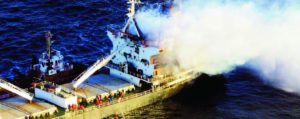The Charity
Aviation
Maritime
Flash fire – welding and painting

Initial Report
This article outlines the rapid outbreak of a fire onboard a vessel in a ship yard during welding operations. Several safety lessons emerge, including the risk of multiple paint layers retaining flammable products which may act as an accelerant.

Note:Photograph for illustration purposes only
What did the reporters tell us?
During welding operations, a fire broke out on the outside of a ship’s superstructure. Within two minutes the entire after side of the superstructure was on fire. Contributing factors are reported to have been the dozen layers of paint found to have been applied, and flammable components between the paint layers arising from allowance of inadequate time between the paint applications.
The welding was conducted on the outside of the superstructure on a deck panel. Sparks dropped into a pile of rubbish which ignited; the fire quickly spread. There was no fire watch set by either ship’s staff or the repair yard. An attempt to extinguish the fire with a ‘high pressure cleaner’ did not work; the fire was later successfully put out.
The lessons to be learnt
This is a salutary report, reminding us of many safety principles applicable during hot work.
The UK MCA’s Code of Safe Working Practices for Merchant Seafarers (2015 edition) (“UKCOSWP 2015”) attends to this in chapter 24. Some key messages relevant to this particular case are contained in the text box below.
Some key messages (UKCOSWP 2015) relevant to this case: hot work.
- Hot work should be subject to a ‘permit to work’.
- Training should have been completed and in date
- Comprehensive precautions against fire and explosion should be taken. “No combustible solids, liquids or gases [should be] adjacent”.
- Supervision and observation should be in place
- Suitable fire extinguishers should be to hand
- All adjacent compartments should be visited on completion
- Frequent checks should be made for at least 2 hours after completion of hot work
NOTE: ALWAYS REFER TO THE FULL TEXT – UKCOSWP 2015, CH 24
We don’t have details of training levels, supervision, or the ‘permit to work’ (PTW) arrangements in place. However it is clear a that precautions against the outbreak of fire were inadequate. There was a failure to clear the area of potential fire risks, no fire watch and no fire extinguishers to hand, which infers a hotwork’ PTW had not been completed, nor adequate supervision provided.
Of particular interest is the speed and spread of the fire, apparently caused by trapped flammable products igniting within the multiple paint layers. Several of the layers were presumably not recently applied, but all or some must have retained combustible products.
Paints are complex substances comprising many constituent parts; many of these can provide fuel to a fire, in particular solvents. These may not leave underlying applications of paint if ‘over-coating’ is done too quickly, or if faster curing coats are applied on top of slower curing ones. Incorrect coat thicknesses, or environmental factors such as excess temperature at the time of application, may also trap solvents. Product data sheets, application instructions and/or makers’ advice are essential to the understanding of risks; in the absence of these or in the case of incomplete historic data, good safety management practice is the appropriate course (including awareness of the generic risks). The key point is that paint in proximity to hot work should always be treated as presenting a high risk of fire. A clean area of work, clearance of rubbish, and paint removal in way of hotwork could have prevented this incident.
CHIRP Suggests
Take hot work seriously. It should never happen without the ship’s (and, if appropriate, the yard’s) leadership and management knowing about and owning the activity and associated precautions. Never treat it as routine. Follow a comprehensive check-off list every time, based on the UKCOSWP 2015 or equivalent guidance. Authorise and supervise the work properly, know what is flammable, remember adjacent compartments, remove everything flammable before work, be alert to the properties of paints in the vicinity, and ensure repeated follow-up checks.







